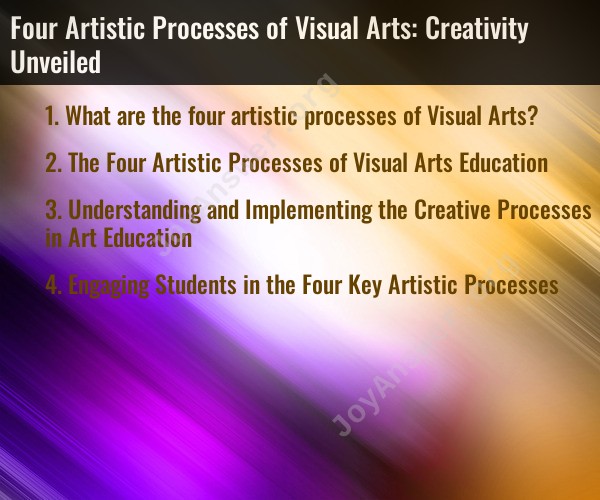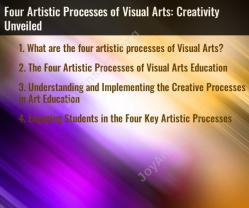What are the four artistic processes of Visual Arts?
In visual arts, there are typically four main artistic processes or components that artists use to create their work. These processes are often interconnected and can be applied in various ways to produce a wide range of artistic expressions. The four artistic processes of visual arts are:
Creating: This process involves the actual act of making art, whether through drawing, painting, sculpting, printmaking, or any other medium. It encompasses the physical and technical aspects of art production, such as selecting materials, using various tools, and applying techniques to create visual forms and compositions. Creating is where the artist's ideas and concepts are transformed into tangible artworks.
Presenting: Presentation is about how the artwork is displayed or exhibited. It includes decisions related to framing, mounting, hanging, lighting, and the physical arrangement of artworks in a gallery or exhibition space. How an artwork is presented can significantly impact how it is perceived and interpreted by the audience.
Responding: The process of responding involves the interpretation and analysis of artworks. Artists and viewers alike engage in this process. Artists may reflect on their work, seeking to understand their own artistic intentions and meanings, while viewers respond to the artwork by interpreting its message, emotions, and symbolism. Art criticism, art history, and art theory are all part of the responding process.
Connecting: Connecting refers to the ways in which art relates to the broader world. This process involves exploring the cultural, historical, and social contexts of the artwork, as well as how it interacts with other works of art and influences other artists. Artists often draw inspiration from their surroundings, experiences, and other artists, and this interplay between art and the world is a crucial part of the creative process.
These four artistic processes are not necessarily linear; they often overlap and influence each other. For example, an artist might respond to their own work during the creating process, leading to revisions and adjustments. Similarly, an artist's connection to the world may influence the subject matter and themes explored during the creating process.
These processes are fundamental in the world of visual arts, helping artists and audiences engage with and understand the significance of artwork. They provide a framework for both the creation and appreciation of visual art, making it a rich and multidimensional form of expression.
The Four Artistic Processes of Visual Arts Education
The four artistic processes of visual arts education are creating, presenting/performing/producing, responding, and connecting. These processes are the cognitive and physical actions by which arts learning and making are realized.
Creating is the process of conceiving and developing new artistic ideas and work. This process can be broken down into the following steps:
- Imagination: Students use their imaginations to come up with new ideas for their artwork.
- Exploration: Students explore different materials and techniques to see how they can be used to express their ideas.
- Refinement: Students refine their ideas and develop their artwork.
- Reflection: Students reflect on their artwork and process.
Presenting/performing/producing is the process of sharing artistic work with others. This process can be broken down into the following steps:
- Preparation: Students prepare their artwork for presentation, performance, or production. This may involve rehearsing, practicing, or editing their work.
- Sharing: Students share their artwork with others. This may involve performing, exhibiting, or publishing their work.
- Reflection: Students reflect on their sharing experience and identify areas for improvement.
Responding is the process of understanding and critiquing artistic work. This process can be broken down into the following steps:
- Observation: Students observe and analyze artistic work.
- Interpretation: Students interpret the meaning of artistic work.
- Evaluation: Students evaluate the quality of artistic work.
- Reflection: Students reflect on their responding experience and identify areas for improvement.
Connecting is the process of making connections between artistic work and other subjects, experiences, and cultures. This process can be broken down into the following steps:
- Identifying connections: Students identify connections between artistic work and other subjects, experiences, and cultures.
- Making meaning: Students make meaning of the connections that they identify.
- Communicating meaning: Students communicate the meaning that they have made to others.
- Reflection: Students reflect on their connecting experience and identify areas for improvement.
Understanding and Implementing the Creative Processes in Art Education
The creative processes are the cognitive and physical actions by which artists create their work. These processes are not linear, and artists may move back and forth between them as they work.
The following are some of the key creative processes that students should engage in:
- Imagination: Artists use their imaginations to come up with new ideas for their work.
- Exploration: Artists explore different materials and techniques to see how they can be used to express their ideas.
- Refinement: Artists refine their ideas and develop their work.
- Reflection: Artists reflect on their work and process.
Art educators can implement the creative processes in their classrooms by providing students with opportunities to:
- Experiment with different materials and techniques.
- Explore different art forms and styles.
- Develop their own artistic voice.
- Reflect on their work and process.
Engaging Students in the Four Key Artistic Processes
Here are some strategies for engaging students in the four key artistic processes:
Creating
- Provide students with opportunities to explore different materials and techniques.
- Encourage students to develop their own artistic voice.
- Help students to reflect on their work and process.
Presenting/performing/producing
- Help students to prepare their artwork for presentation, performance, or production.
- Provide students with opportunities to share their artwork with others.
- Encourage students to reflect on their sharing experience.
Responding
- Help students to observe and analyze artistic work.
- Teach students how to interpret the meaning of artistic work.
- Help students to evaluate the quality of artistic work.
- Encourage students to reflect on their responding experience.
Connecting
- Help students to identify connections between artistic work and other subjects, experiences, and cultures.
- Help students to make meaning of the connections that they identify.
- Help students to communicate the meaning that they have made to others.
- Encourage students to reflect on their connecting experience.
By engaging students in the four key artistic processes, art educators can help them to develop their creativity, critical thinking skills, and problem-solving skills.


